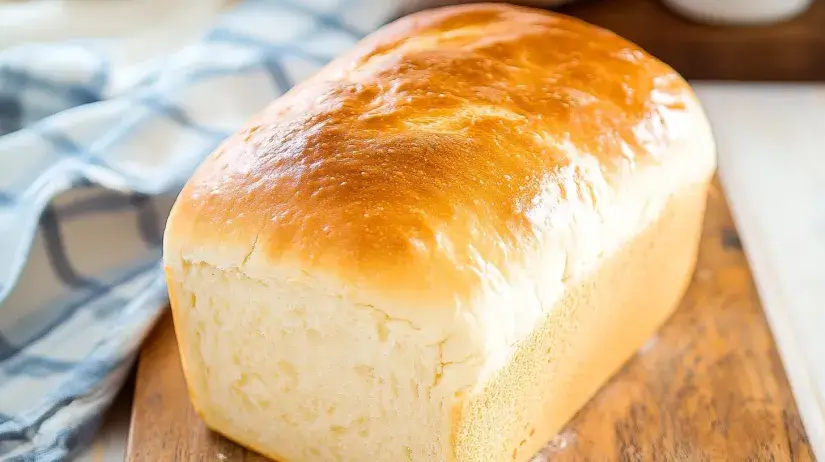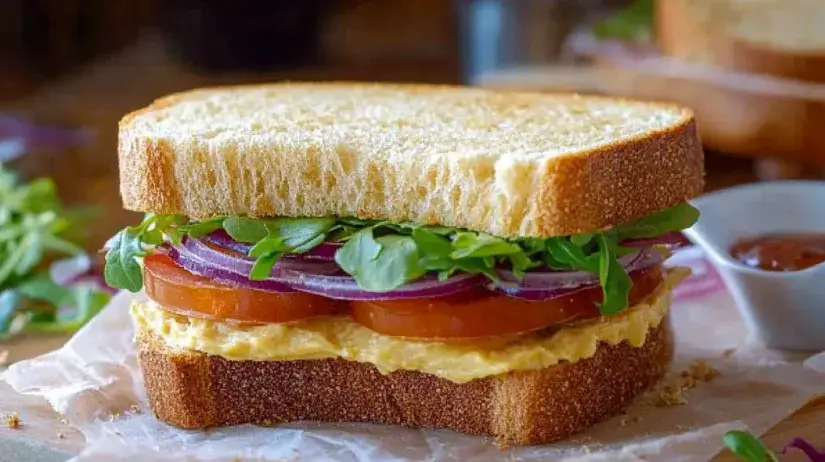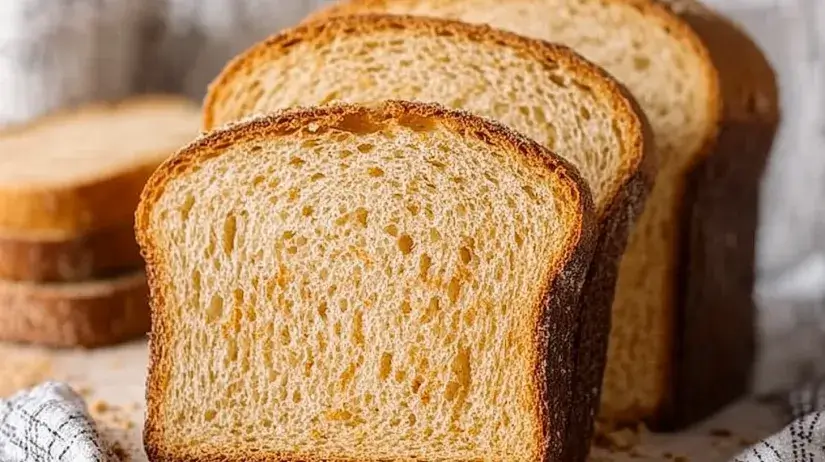Enjoy the delightful aroma and satisfying texture of freshly baked sandwich bread recipe from your own kitchen. This guide will show you how to make the perfect homemade loaf. It’s great for sandwiches, toast, and more. Whether you’re a seasoned baker or new to the kitchen, you’ll learn to make a soft, fluffy, and flavorful sandwich bread recipe that your family will love.
Table of Contents
Key Takeaways
- Discover the essential ingredients for creating a delicious homemade sandwich bread recipe
- Understand the role of various types of flour and the importance of yeast in bread making
- Learn about the necessary kitchen tools and equipment required for successful bread baking
- Explore the science behind successful bread making, including kneading, proofing, and temperature/humidity factors
- Receive step-by-step instructions for the complete sandwich bread recipe
Essential Ingredients for Perfect Sandwich Bread
Making the perfect homemade sandwich bread recipe needs careful picking of ingredients. Each part plays a key role in the bread’s texture, taste, and shape.
Understanding Different Types of Flour
The base of any great bread is the flour. For sandwich bread recipe, mix bread flour and all-purpose flour. Bread flour’s high protein makes the bread soft yet strong. All-purpose flour adds a tender, light touch.
The Role of Yeast in Bread Making
Yeast is crucial for making your dough light and airy. You can use active dry yeast or instant yeast. Active dry yeast needs to be activated first. Instant yeast goes straight into the dry ingredients.

Optional Ingredients for Enhanced Flavor
- Sugar feeds the yeast, helps browning, and adds sweetness.
- Salt boosts flavor and balances sweetness.
- Milk powder makes the bread softer and richer.
Knowing each ingredient’s role helps make a sandwich bread recipe that looks good and tastes great. It will be perfectly textured too.
Required Kitchen Tools and Equipment
Baking homemade sandwich bread recipe is a rewarding experience. It requires a few essential tools and equipment. From mixing the dough to shaping the loaf, the right gear makes a big difference.
A reliable stand mixer is at the heart of bread-making. It kneads the dough well, making it smooth and elastic. This is key for light and airy sandwich bread. You also need a bread pan to shape the dough into a classic loaf.
Other important tools include a dough scraper and a kitchen scale. They help you handle the dough and measure ingredients precisely. A thermometer is also crucial. It helps you check the bread’s internal temperature for a golden-brown crust.
- Stand mixer
- Bread pan
- Dough scraper
- Kitchen scale
- Thermometer
With these tools, you’ll be ready to bake delicious sandwich bread. It will impress your family and friends.
The Science Behind Successful Bread Making
Baking bread is more than just following a recipe. It’s a mix of science and technique. Knowing about gluten, fermentation, and how the environment affects it can make a big difference in getting the perfect loaf.
Proper Kneading Techniques
Kneading is key to developing the gluten in your dough. By folding and stretching the dough, you help the gluten proteins form a strong network. This traps the carbon dioxide from yeast, making the bread light and airy.
Understanding Proofing and Rising
Proofing lets yeast ferment and produce carbon dioxide. This makes the dough expand and creates air pockets. The length of proofing affects the bread’s flavor and texture, influencing gluten development and fermentation.
Temperature and Humidity Factors
Environmental conditions are crucial for bread baking. The right dough hydration and proofing time depend on temperature and humidity. Having the perfect kitchen environment can greatly improve your bread’s outcome.

| Factor | Optimal Range | Impact on Bread |
|---|---|---|
| Temperature | 75-85°F (24-29°C) | Affects yeast activity and dough rise |
| Humidity | 60-80% | Impacts dough hydration and crust formation |
Sandwich Bread Recipe: Complete Instructions
Making your own sandwich bread recipe is a fun and rewarding task. Follow these easy steps to make a delicious loaf. It will make your lunchtime meals even better.
Ingredients and Measurements
- 3 cups (375g) of all-purpose flour
- 1 teaspoon of salt
- 1 tablespoon of granulated sugar
- 1 packet (2 1/4 teaspoons) of active dry yeast
- 1 1/4 cups (300ml) of warm water (between 105°F – 115°F or 40°C – 46°C)
- 2 tablespoons of unsalted butter, melted
Step-by-Step Instructions
- In a large mixing bowl, combine the flour, salt, sugar, and yeast. Stir until well mixed.
- Add the warm water and melted butter to the dry ingredients. Mix the dough until it starts to come together.
- Turn the dough out onto a lightly floured surface. Knead for about 10 minutes, until smooth and elastic.
- Place the dough in a lightly greased bowl. Cover with a damp towel or plastic wrap. Let it rise in a warm, draft-free area for 1 hour or until doubled in size.
- Punch down the dough to release air bubbles. Shape it into a loaf and place in a greased 9×5 inch bread pan.
- Cover the pan and let the dough rise for an additional 30 minutes.
- Preheat your oven to 375°F (190°C).
- Bake the bread for 30-35 minutes, or until the internal temperature reaches 195°F (91°C).
- Remove the bread from the oven. Let it cool in the pan for 5 minutes before transferring to a wire rack to cool completely.
Your homemade bread recipe is now ready to enjoy! Slice and serve as desired. Remember to store any leftover bread in an airtight container for up to 5 days.
Tips for Achieving the Perfect Texture
Making the perfect sandwich bread recipe is all about the texture. You want it soft inside and golden outside. Here are some tips to get that perfect texture for your homemade bread.
Common Texture Problems and Solutions
Having dense or heavy bread is a common problem. Uneven rising can also happen. To fix these, focus on kneading and proofing.
Developing gluten and controlling fermentation are crucial. Adjusting dough hydration and proofing time can help a lot.
Achieving a Golden-Brown Crust
The crust’s color is the first thing you notice. A golden-brown crust is a sign of well-baked bread. To get this, pay attention to baking temperature and time.
Try different oven settings and watch your bread closely. Using steam early in baking can also help.
Creating the Ideal Crumb Structure
The bread’s inside should be soft and airy. To get this, use high-quality flour and yeast. The right amount of water and proper rising conditions are also key.
| Texture Characteristic | Desired Outcome | Potential Solutions |
|---|---|---|
| Soft Bread | Pillowy, tender texture | Proper kneading, controlled proofing, maintaining optimal hydration |
| Fluffy Texture | Light and airy crumb | Accurate yeast and flour proportions, thorough kneading, adequate proofing |
| Crust Color | Golden-brown, crisp exterior | Adjusting baking temperature and duration, utilizing steam during baking |
| Crumb Texture | Soft, even distribution | Selecting high-quality flour, maintaining proper hydration, controlled fermentation |
Storage and Shelf Life Guidelines
Keeping your homemade sandwich bread recipe fresh is key to enjoying it fully. Proper bread storage helps extend its shelf life and prevents mold. Here are the best ways to keep your bread fresh and tasty.
Room Temperature Storage
For up to 4 days, you can store your bread at room temperature. Use a bread box or paper bag. This allows air to circulate and keeps the bread from getting too moist or stale.
Refrigeration for Extended Freshness
For longer storage, the fridge is your ally. Wrap the loaf in plastic wrap or a resealable bag. It can stay fresh for up to 1 week in the fridge.
Freezing for Long-Term Storage
- Freezing is great for longer bread storage.
- Wrap the loaf or slices in plastic wrap or foil, then in a freezer-safe bag or container.
- Frozen bread stays fresh for up to 3 months in the freezer.
When you’re ready to use frozen bread, thaw it at room temperature. This helps it regain its soft, fluffy texture and avoids “freezer burn.”
By following these storage tips, your homemade sandwich bread will stay fresh and delicious. Enjoy it for quick lunches or special teatime treats.

Troubleshooting Common Bread Making Mistakes
As a home baker, you might face some issues when making sandwich bread recipe. Don’t worry! This section will help you identify and fix common problems. This way, you’ll always get great results.
Fixing Dense or Heavy Bread
If your bread is dense and heavy, there could be a few reasons. First, check if you’re proofing it right. Overproofing can make the dough collapse, leading to a dense texture. On the other hand, underproofing can also result in a heavy loaf. Make sure the dough rises for the right amount of time and doubles in size.
Another thing to check is your kneading technique. If you don’t knead enough, the dough won’t have the right structure. Spend more time kneading to make the dough elastic and airy.
Addressing Uneven Rising Issues
- Uneven rising can be due to overproofing or underproofing. Watch the proofing time closely and adjust as needed.
- Make sure you knead the dough well to build the gluten network. This helps it rise evenly.
- Also, check your kitchen’s temperature and humidity. Extreme conditions can mess with the rising process, causing uneven results.
| Common Issue | Potential Causes | Solutions |
|---|---|---|
| Dense or Heavy Bread | Overproofing Underproofing Insufficient kneading | Adjust proofing time Knead the dough thoroughly |
| Uneven Rising | Overproofing Underproofing Improper kneading Temperature and humidity issues | Monitor proofing time Knead the dough properly Maintain ideal kitchen conditions |
By tackling these common bread-making issues, you’ll get better at baking. Keep trying, and don’t hesitate to experiment. Find the best technique for your kitchen and taste preferences.
Variations and Flavor Adaptations
Explore the endless possibilities of homemade sandwich bread recipe. You can make it with whole wheat bread, multigrain bread, or herb-infused bread. The basic recipe is easy to change to match your taste.
Try adding whole wheat flour or multigrain flours for a healthier option. This boosts the bread’s fiber and adds a nice texture and flavor. You can also add herbs like rosemary, thyme, or oregano for a savory taste.
For a sweet treat, make sweet bread variations. Add ripe bananas, dried fruit, or cinnamon and sugar. This makes a delicious bread perfect for breakfast or a snack. Let your imagination run wild and make a bread that you love.
| Bread Variation | Ingredients | Flavor Profile |
|---|---|---|
| Whole Wheat Bread | Whole wheat flour, all-purpose flour, yeast, water, salt, honey | Nutty, earthy, and wholesome |
| Multigrain Bread | Whole wheat flour, rye flour, oats, cornmeal, yeast, water, salt, honey | Hearty, complex, and nutrient-dense |
| Herb-Infused Bread | All-purpose flour, yeast, water, salt, fresh or dried herbs (e.g., rosemary, thyme, oregano) | Fragrant, savory, and aromatic |
| Sweet Bread | All-purpose flour, yeast, water, salt, sugar, eggs, butter, fruits or cinnamon | Rich, indulgent, and perfect for breakfast or dessert |
Enjoy baking and let your creativity flow with these bread variations. They can make your sandwiches, toast, and more taste amazing.
Conclusion
Making your own sandwich bread recipe at home is incredibly rewarding. This article has given you the tools to become a pro at baking delicious homemade bread. You can now enjoy the convenience of fresh bread and the unique flavors that store-bought can’t match.
Baking your own bread has many perks. You get to choose what goes into it and save money. As you get better, you’ll learn how to make bread that’s just right – perfect texture, crust, and crumb. Don’t be afraid to try new flavors and make the recipe your own.
Keep exploring the world of homemade bread baking. Be curious, patient, and ready to try new things. The more you bake, the better you’ll get. Enjoy every step, relish the outcome, and share your passion with others.
FAQ
What are the essential ingredients for making homemade sandwich bread?
To make homemade sandwich bread recipe, you need bread flour, active dry yeast, and water. You also need sugar, salt, and milk powder or butter. These ingredients create the perfect texture and flavor.
What types of flour can be used for sandwich bread?
You can use bread flour or all-purpose flour for sandwich bread recipe. Bread flour has more protein, making the bread chewy and sturdy. All-purpose flour makes the bread softer.
How does the yeast affect the bread-making process?
Yeast is key for the bread’s rise and lightness. It eats the dough’s sugars, producing gas that makes the dough expand. Both active dry and instant yeast work well in sandwich bread recipe.
What kitchen tools and equipment are needed for making homemade sandwich bread?
You’ll need a stand mixer with a dough hook, a large bread pan, and a dough scraper. A kitchen scale and digital thermometer are also essential. These tools help you mix, knead, and bake the perfect loaf.
How do I achieve the optimal texture for sandwich bread?
For the best texture, knead the dough well to develop gluten. Control the proofing and rising times. Bake at the right temperature. Cool the bread completely before slicing.
How should I store homemade sandwich bread to maintain freshness?
Cool the bread completely before storing it in an airtight container or bread bag. It stays fresh for 3-5 days. Freeze it for up to 3 months, wrapped tightly to prevent freezer burn.
What are some common bread-making mistakes and how can I avoid them?
Common mistakes include overproofing, underproofing, and kneading too little or too much. These can make the bread dense or uneven. Follow the recipe closely and watch the dough’s rise and development.
Can I customize the basic sandwich bread recipe?
Yes, you can customize the basic recipe. Try adding whole wheat flour, herbs, or spices. Experiment with sweet variations like cinnamon-raisin or honey-oat bread. Adjust ingredients and baking times for unique flavors.
